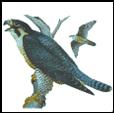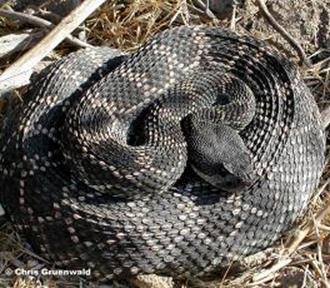



|
Where birds of a feather flock together. |
|
Audubon Hills Association (AHA!) Est. 1968 |

|
Living with rattlesnakes |
|
Rattlesnakes are usually identified by their warning rattle - as heard when you clicked on this webpage.† Itís a hiss or buzz - made by the rattles at the tip of their tails. A rattlesnake is born with a button, or rattler, and acquires a new rattle section each time it molts. |
Identification |

|
Falcon Lane |
|
El Dorado County Website -† LIVING WITH RATTLESNAKES. Habitat Modification
|

|
Rattlesnakes also are distinguished by having rather flattened, triangular heads. The heads of rattlesnakes are about twice as wide as their necks. Rattlesnakes come in a great variety of colors, depending on the species and stage of molt. Most rattlers are various shades of brown, tan, yellow, gray, black, chalky white, dull red, and olive green. Many have diamond, chevron, or blotched markings on their backs and sides. |

|
Hiding places under buildings, piles of debris, or vegetation that has ground-level foliage also provides attractive hiding places for rattlesnakes, so it should be removed or properly pruned. Tight-fitting doors will prevent snakes from entering outbuildings. The foundations of all buildings should be sealed or tightly screened with 1/4-inch (0.6-cm) wire mesh to keep out snakes. When feasible, the most effective way for a homeowner to protect a child's play area from rattlesnakes is to construct a rattlesnake-proof fence. The fencing must be tight. If wire mesh is used, it should be 1/4-inch (0.6-cm) mesh and about 3 feet (1 m) high. Bury the bottom 3 or 4 inches (8 or 10 cm) or bend outward 3 or more inches of the base of the wire to discourage other animals from digging under the fence. Frightening No methods are known that will frighten rattlesnakes. Sounds certainly will not work because snakes are deaf. |
|
Striking Rattlesnakes usually see humans before humans see them, or they detect soil vibrations made by walking. They coil for protection, but they can strike only from a third to a half of their body length. Rattlers rely on surprise to strike prey. Once a prey has been struck, but not killed, it is unlikely that it will be struck again. Experienced rodents and dogs can evade rattlesnake strikes. If a rattlesnake has just been killed by cutting off its head, it can still bare its fangs and bite. The heat sensory pits will still be functioning, and the warmth of a hand will activate the striking reflex. The head cannot strike, but it can bite and inflict venom. The reflex no longer exists after a few minutes, or as long as an hour or more if it is cool, as rigor mortis sets in. |

|
Snake Bite The greatest danger to humans from rattlesnakes is that small children may be struck while rolling and tumbling in the grass. Only about 1,000 people are bitten and less than a dozen people die from rattlesnake venom each year in the United States. Nevertheless, it is a most unpleasant experience to be struck. The best protection for humans in snake country is common sense in choosing protective foot and leg wear. Beware of putting a hand up over rocks. Rattlesnakes might be waiting there for a rodent, and the warmth in a hand may cause the snake to strike reflexively. Care should be taken at night, when snakes are more active, and the chance of stepping on a snake is greater. Fortunately, rattlesnakes try to avoid people. The best first aid for a poisonous snake bite is to seek immediate medical care and to keep the victim calm, warm, and reassured. Do not drink alcohol or use ice, cold packs, or Freon spray to treat the snake bite or cut the wound, as was once recommended. The causes of human death from rattlesnake venom are varied, but usually occur from extended hypotension and cardiopulmonary arrest. Usually within a few minutes after being struck the victim will experience pain and swelling at the wound site. |
